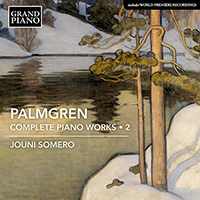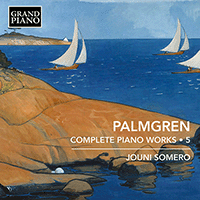
About this Release
“Nearly all the tracks in this album are world première recordings. Rarities include two early manuscripts, Serenad SP252 ja Vandring i skogen SP327, which had been stored in the archives of the Sibelius Museum for decades. My personal favourites among the pieces of this album are the Trois Morceaux, Op. 74 written in Paris in 1921, and which reflect so well the atmosphere of Paris in the 1920s. The Eight Pieces, Op. 75, written in New York in 1921, is a wonderful collection of character pieces. The album culminates with two marches that are known basically by every Finn. Yet, these two arrangements had been totally forgotten.” — Jouni Somero
PALMGREN, SELIM (1878–1951)
Complete Piano Works • 7
- Jouni Somero, piano
Selim Palmgren was one of the most prominent composer-pianists of his era, and is also noted as one of the earliest composers of Impressionist piano miniatures, beautifully represented in the nostalgic atmosphere of his Impromptu dans la solitude, Op. 63, No. 2. The autobiographical Päiväkirjan lehtisiä, Op. 109 (‘Diary Sheets’) belongs amongst Palmgren’s final works for the piano. This seventh volume in Jouni Somero’s acclaimed edition of Palmgren’s complete piano works includes many rarities and premiere recordings.
Tracklist
|
1
Impromptu in B-Flat Major, Op. 63, No. 1 (1918) (00:04:09)
|
|
2
Impromptu dans la solitude, Op. 63, No. 2 (1918) (00:04:30)
|
|
3
Champagne-impromptu, Op. 63, No. 3 (1918) (00:02:14)
|
|
4
Valse-impromptu, Op. 63, No. 4 (1918) (00:02:25)
|
|
Päiväkirjan lehtisiä (Tuokiokuvia, Ögonblicksbilder, Diary Sheets), Op. 109 (1946) (00:10:00 )
|
|
5
No. 1. Kunniaportti (Honorary Arch) (00:01:41)
|
|
6
No. 2. Huoleton menuetti (Careless Menuet) (00:00:39)
|
|
7
No. 3. Rukous (Prayer) (00:01:52)
|
|
8
No. 4. Odottaessa (Waiting) (00:01:18)
|
|
9
No. 5. Levottomuus (Anxiety) (00:01:05)
|
|
10
No. 6. Pahat voimat (Evil Forces) (00:00:42)
|
|
11
No. 7. Toivon pilkahdus (Ray of Hope) (00:01:00)
|
|
12
No. 8. Voitto (Victory) (00:01:33)
|
|
13
Serenade in G Minor (1890) (00:02:49)
|
|
14
Humoresk på en baskvint (Humoresque on a Left-hand Fifth) (1920) (00:01:08)
|
|
15
Vandring i skogen (Wandering in the Woods) (1900) (00:01:00)
|
|
16
Entre'act valsant (1921) (00:02:40)
|
|
17
Morceau romantique, Op. 74, No. 1 (1921) (00:03:29)
|
|
18
Morceau élégant, Op. 74, No. 2 (1921) (00:01:57)
|
|
19
Morceau bourlesque, Op. 74, No. 3 (1921) (00:02:16)
|
|
Finska rytmer (Finnish Rhythms, 5 Sketches from Finland), Op. 31 (1911) (00:02:00 )
|
|
20
No. 1. Karelsk dans (Karelian Dance) (00:00:46)
|
|
21
No. 2. Menuett (00:01:51)
|
|
22
No. 3. Det onda samvetet (A Guilty Conscience) (00:01:11)
|
|
23
No. 4. Menuett-Vals (Minuet Waltz) (00:01:30)
|
|
24
No. 5. Vestfinsk Dans (Finlandish Dance) (00:01:10)
|
|
25
Rondo, Op. 75, No. 1 (1921) (00:04:25)
|
|
26
Intermezzo, Op. 75, No. 2 (1922) (00:02:12)
|
|
27
Elegy, Op. 75, No. 3 (1921) (00:03:46)
|
|
28
Barcarolle, Op. 75, No. 4 (1922) (00:02:24)
|
|
29
Canzonetta, Op. 75, No. 5 (1921) (00:02:03)
|
|
30
The Hunter and the Squirrel, Op. 75, No. 6 (1922) (00:01:34)
|
|
31
Why?, Op. 75, No. 7 (1922) (00:02:45)
|
|
32
Hymn of Praise, Op. 75, No. 8 (1922) (00:01:35)
|
|
33
Carl XIIs marsch vid Narva (The March of Narva) (arr. S. Palmgren for piano) () (00:02:56)
|
|
34
Björneborgarnes marsch (Porilaisten marssi, March of the Pori Regiment) (arr. S. Palmgren for piano) () (00:02:02)
|
The Artist(s)
 Jouni Somero is one of the most active performers among present Finnish musicians. He has given over 3,100 concerts in many countries worldwide. He studied piano in Switzerland and at the Music Academy in Cologne under Professor Herbert Drechsel, and, under the legendary Hungarian pianist Georges Cziffra, he deepened his knowledge of the interpretation of Liszt’s music. Michael Ponti, the American virtuoso, has also acted as Somero’s musical advisor. Jouni Somero’s recording career began in 1989 (with Liszt’s 12 Transcendental Études), after which he has made over 100 recordings for different labels, including Naxos. His wide repertoire includes all the solo piano works of Rachmaninov, Tchaikovsky and Bortkiewicz, as well as seldomly heard music by, among others, Alkan, Godowsky, Rubinstein, Reinhold, Godard, Cui and Gottschalk. He has also made several piano arrangements of orchestral, operatic and pop music, and his YouTube channel has gained millions of views.
Jouni Somero is one of the most active performers among present Finnish musicians. He has given over 3,100 concerts in many countries worldwide. He studied piano in Switzerland and at the Music Academy in Cologne under Professor Herbert Drechsel, and, under the legendary Hungarian pianist Georges Cziffra, he deepened his knowledge of the interpretation of Liszt’s music. Michael Ponti, the American virtuoso, has also acted as Somero’s musical advisor. Jouni Somero’s recording career began in 1989 (with Liszt’s 12 Transcendental Études), after which he has made over 100 recordings for different labels, including Naxos. His wide repertoire includes all the solo piano works of Rachmaninov, Tchaikovsky and Bortkiewicz, as well as seldomly heard music by, among others, Alkan, Godowsky, Rubinstein, Reinhold, Godard, Cui and Gottschalk. He has also made several piano arrangements of orchestral, operatic and pop music, and his YouTube channel has gained millions of views. The Composer(s)
 During the first decades of the past century Selim Palmgren, a pupil of Ferruccio Busoni and Conrad Ansorge, was undoubtedly one of the most performed Nordic composers of piano music. His piano works, including hundreds of pieces and five piano concertos, were being widely performed, and even recorded, by some of the greatest pianists of the era, including Ignaz Friedman, Myra Hess, Wilhelm Backhaus, Benno Moiseiwitch and conducted by star conductors the likes of Arthur Nikisch, Leopold Stokowski and Václav Talich, to name a few. Palmgren’s music was being widely published and distributed by well-known music publishers both in the US and in Europe.
During the first decades of the past century Selim Palmgren, a pupil of Ferruccio Busoni and Conrad Ansorge, was undoubtedly one of the most performed Nordic composers of piano music. His piano works, including hundreds of pieces and five piano concertos, were being widely performed, and even recorded, by some of the greatest pianists of the era, including Ignaz Friedman, Myra Hess, Wilhelm Backhaus, Benno Moiseiwitch and conducted by star conductors the likes of Arthur Nikisch, Leopold Stokowski and Václav Talich, to name a few. Palmgren’s music was being widely published and distributed by well-known music publishers both in the US and in Europe. Reviews
“Somero has assembled an attractively shaped program here. …This recital, like the whole series, is obviously a labour of love by Somero, and his playing is colourful and fully engaged.” – Fanfare







 Grand Piano has gained a reputation for producing high quality recordings of rare keyboard gems. Dedicated to the exploration of undiscovered piano repertoire, the label specialises in complete cycles of piano works by many lesser-known composers, whose output might otherwise have remained unknown and unrecorded.
Grand Piano has gained a reputation for producing high quality recordings of rare keyboard gems. Dedicated to the exploration of undiscovered piano repertoire, the label specialises in complete cycles of piano works by many lesser-known composers, whose output might otherwise have remained unknown and unrecorded.






